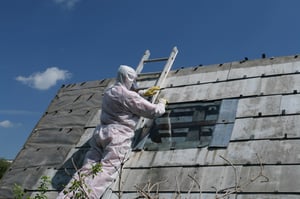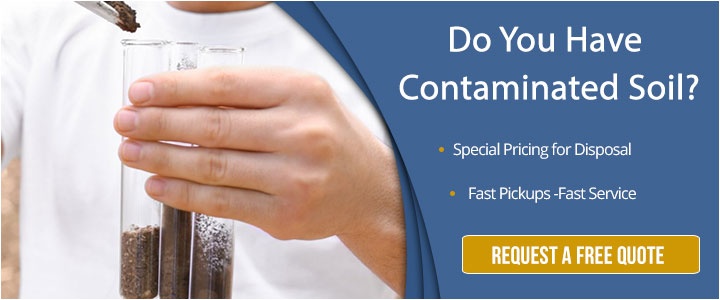The discovery of asbestos can bring a project to an abrupt stop. Although asbestos is part of nature in many cases, it can be a risk to human health when unearthed.
In California, there are many regions of the state where asbestos is known to exist in soil. If your project involves digging in one of these areas, or you’ve unexpectedly come across asbestos fibers, it’s important to know what the disposal process looks like to get back on track.
Here are some frequently asked questions about this construction roadblock and what to do when you need asbestos contaminated soil disposal.
How Does Asbestos Get In Soil?
One of the most common questions about asbestos soil contamination is how it got there in the first place. 
Asbestos is naturally occurring and is made up of thin, microscopic silicate fibers. When a ground disturbance occurs, such as construction or a natural weathering process, naturally-occurring asbestos can be released from rocks or soils.
Asbestos is also used in many building construction materials. Some estimates show it is a component in more than 3,000 types of materials, including insulating board, millboard, thermal insulation and sprayed insulation. When these materials are disposed of, asbestos can enter the ground soil.
Is Asbestos Hazardous Waste?
When the word, “asbestos” is uttered, it’s common to immediately think of the harmful effects. The U.S. Department of Health and Human Services has classifed asbestos as a known human carcinogen. In other words, it’s a substance that is known to cause cancer.
When many states classify asbestos as non- hazardous waste, in California, asbestos is considered to be hazardous. State laws say that asbestos waste weighing more than 50 pounds requires transportation by a certified hazardous waste disposal company.
However, the U.S. Environmental Protection Agency (EPA) is proposing additional restrictions on asbestos and is targeting disposal and recordkeeping requirements that would further align with industry standards, Occupational Safety and Health Administration requirements and the Asbestos National Emission Standards for Hazardous Air Pollutants.
A proposed rule would also ban chrysotile asbestos, the only known form of asbestos that is currently imported into the United States. This type of asbestos is commonly found in products like sheet gaskets, brake blocks, asbestos diaphragms and other vehicle friction products.
More hazardous waste laws impacting asbestos disposal could also be on the horizon, as the EPA release outlining the proposed ban on chrysotile asbestos fibers addressed evaluating other types of asbestos fibers in the future.
How Do You Determine If Soil Disposal Is Needed?
The California Air Resource Board (CARB) implemented the Airborne Toxic Control Measure for projects that disturb soil in areas of the state where asbestos may be present. Projects can include construction, grading and surface mining.
Before any construction begins, project operators must apply for an Asbestos Dust Mitigation Plan or test out of any requirements by undergoing a geologic evaluation through an air district office. This type of plan should include an emergency procedure if asbestos is unearthed in the soil.
Before beginning any project, it’s important that workers are trained in the event that asbestos is found in soil. This includes knowing which personal protective equipment (PPE) to have on site to protect against hazardous levels of exposure.
Even if no asbestos is found at the beginning of digging, it’s also important to implement ongoing asbestos sampling during the project’s duration. If asbestos is found at any point, you may need to dispose of it properly. Some projects may allow for contaminated soil to remain on the property if it is in a manageable and safe long-term area. Any enforcing agencies such as the EPA must approve this; otherwise, the soil must be removed.
How Is Asbestos Removed And Disposed Of?
There are generally two options when asbestos has contaminated soil at a worksite:
- Asbestos litter picking method
- Excavation
The first option is an asbestos litter picking method. This is usually only an option when the asbestos is visible to the eye, such as in large fragments. A contractor will come to the site, bag the contaminated pieces and remove them from the property. Adequate control measures must be put into place and should be conducted by a licensed and experienced professional.
The other option is excavation or the full removal of the soil from the land. When the asbestos is scattered and in fibrous form, this is really the only true option. In general, a heavy machine will come to the site and perform the asbestos removal. Soil is placed in a heavy goods vehicle (HGV).
In both situations, the asbestos is transported to landfills or waste sites that are licensed to accept asbestos for disposal.
Is It Necessary To Work With A Waste Disposal Company?
In California, asbestos waste weighing more than 50 pounds requires transportation by a certified hazardous waste disposal company. It’s also important to note that even if your company discovers fewer than 50 pounds of asbestos, you’re still responsible for ensuring that waste safely arrives at an approved facility that will accept it.
Working with an experienced waste disposal company is not only a good idea, it’s good business. In California, certain quantities of asbestos are already subject to disposal regulations. Changes at the federal level could impact these laws further, whether you are dealing with small or large quantities of asbestos waste.
Working with hazardous waste disposal companies can help to ensure you are meeting all current and future asbestos disposal laws. The best disposal companies have extensive experience and knowledge of new and pending legislation and how these laws could impact your specific project if you plan to dig and unearth soil.
A hazardous waste disposal company will not only respond to an incident for removal of asbestos, but also help you develop a practical plan in advance if you are working in an area known for asbestos contamination. This way, your waste management practices are proactive rather than reactive.
What A Soil Disposal Company Should Offer
If soil samples reveal asbestos contamination, it’s important to work with an experienced company that will ensure your excavated materials safely arrive to the appropriate disposal facility.
Prior to your project commencing, a disposal company should offer a walk-through program at your site. A walk-through program is consultative in nature and evaluates your waste procedures. Even if asbestos if not found on site, you may have other hazardous materials and debris that requires proper disposal. It is important to have a plan in place before you begin since laws are continuously changing.
A hazardous waste disposal company should also:
- Have the ability to identify waste streams through profiling and testing
- Transport your waste to the proper recycling and disposal sites
- Offer evidence that your waste has been properly disposed of
- Provide the documentation and information necessary for transport, including manifests
Ensure that the vendor you choose is on the California Department of Toxic Substances Control’s Registered Hazardous Waste Transporter Database. A hazardous waste transporter registration is valid for only one year, so it’s a good idea to conduct annual environmental audits of vendors handling your waste.
California has some of the strictest regulations on the books when it comes to hazardous waste disposal. That includes asbestos, which currently is not regulated at the federal level. However, as we mentioned above, that may soon change.
Establishing a working relationship with an experienced disposal vendor will help put you in a position to adapt to any changes in the pipeline while ensuring you are meeting all current regulations.


Comment